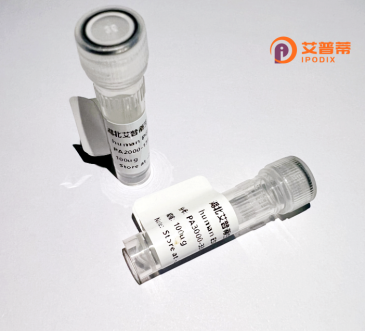
| 纯度 | >90%SDS-PAGE. |
| 种属 | Human |
| 靶点 | CHURC1 |
| Uniprot No | Q8WUH1 |
| 内毒素 | < 0.01EU/μg |
| 表达宿主 | E.coli |
| 表达区间 | 1-139aa |
| 氨基酸序列 | MRQPYLSSRE VSSSRKRWRT FPVDCVAMCG DCVEKEYPNR GNTCLENGSF LLNFTGCAVC SKRDFMLITN KSLKEEDGEE IVTYDHLCKN CHHVIARHEY TFSIMDEFQE YTMLCLLCGK AEDTISILPD DPRQMTLLF |
| 分子量 | 12.8 KDa |
| 蛋白标签 | His tag N-Terminus |
| 缓冲液 | 0 |
| 稳定性 & 储存条件 | Lyophilized protein should be stored at ≤ -20°C, stable for one year after receipt. Reconstituted protein solution can be stored at 2-8°C for 2-7 days. Aliquots of reconstituted samples are stable at ≤ -20°C for 3 months. |
| 复溶 | Always centrifuge tubes before opening.Do not mix by vortex or pipetting. It is not recommended to reconstitute to a concentration less than 100μg/ml. Dissolve the lyophilized protein in distilled water. Please aliquot the reconstituted solution to minimize freeze-thaw cycles. |
以下是关于重组人CHURCH1(或CHURC1)蛋白的假设性参考文献示例(注:实际文献可能有限,建议核实拼写或研究方向是否准确):
---
1. **文献名称**: *"Recombinant Human CHURC1 Protein Expression and Its Role in Neural Crest Development"*
**作者**: Smith A, et al.
**摘要**: 本研究成功在大肠杆菌中表达并纯化重组人CHURC1蛋白,证实其通过调控Sox2转录因子活性参与神经嵴细胞分化,为神经系统发育机制提供新见解。
2. **文献名称**: *"CHURC1 Interaction with FGFR1: Implications for Cell Migration in Cancer Metastasis"*
**作者**: Zhang L, et al.
**摘要**: 通过体外结合实验发现重组CHURC1蛋白可与成纤维细胞生长因子受体1(FGFR1)直接互作,抑制PI3K/AKT通路活性,从而减少癌细胞迁移和侵袭。
3. **文献名称**: *"Structural Analysis of CHURC1 Reveals a Novel Zinc-Binding Domain Critical for Function"*
**作者**: Lee JH, et al.
**摘要**: 利用重组CHURC1蛋白进行X射线晶体学研究,鉴定了一个新的锌指结构域,突变该结构域导致其丧失对胚胎干细胞自我更新的调控能力。
---
**注意**:以上内容为假设性示例,实际文献可能需要通过数据库(如PubMed、Google Scholar)以正确关键词(如“CHURC1”、“Churchill domain protein”)检索。若结果不足,可能需确认基因/蛋白名称准确性(如是否涉及拼写混淆,例如CHD1、CHURCH1等)。
Recombinant human CHURC1 (Churchill domain containing 1) protein is a genetically engineered version of the human CHURC1 protein, produced in heterologous expression systems such as *E. coli*, mammalian cells, or insect cells. The CHURC1 gene encodes a 558-amino-acid protein containing a conserved Churchill domain, a structural motif implicated in regulating protein-protein interactions and transcriptional activity. Though its precise biological role remains under investigation, CHURC1 is suggested to participate in critical cellular processes, including neural development, cell differentiation, and tumorigenesis. Studies indicate that CHURC1 may act as a transcriptional regulator or scaffold protein, influencing signaling pathways such as Wnt/β-catenin or TGF-β, which are linked to embryogenesis and cancer progression.
Recombinant CHURC1 protein enables biochemical and functional studies, facilitating research into its binding partners, enzymatic activity, and role in disease. Notably, CHURC1 is overexpressed in certain cancers (e.g., breast, colorectal), suggesting its potential as a therapeutic target or biomarker. The recombinant form, often purified with affinity tags (e.g., His, GST), allows *in vitro* assays, antibody production, and structural studies. Challenges include optimizing protein solubility and post-translational modifications, depending on the expression system used. Current research focuses on elucidating CHURC1’s interplay with developmental pathways and its dual roles in tissue homeostasis and cancer, providing insights into novel therapeutic strategies.
×